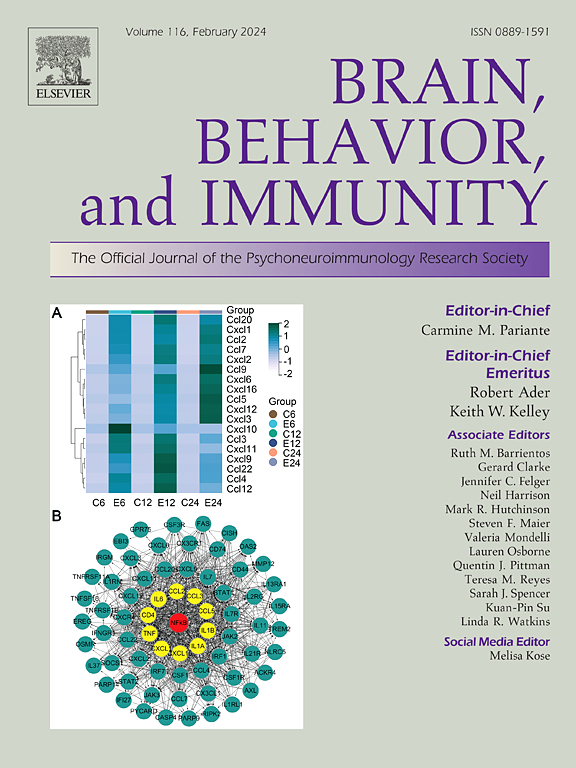No association of posttraumatic stress disorder with epigenetic aging in women at mid-life: A longitudinal cohort study
IF 8.8
2区 医学
Q1 IMMUNOLOGY
引用次数: 0
Abstract
Posttraumatic stress disorder (PTSD) is associated with mortality and increased risk of diseases of aging, but underlying mechanisms remain unclear. We examine associations of PTSD with one potential pathway, accelerated epigenetic aging. In a longitudinal cohort of trauma-exposed middle-aged women (n = 831, n observations = 1,516), we examined cross-sectional and longitudinal associations between PTSD, with and without comorbid depression, and epigenetic aging measured by six clocks at two time points approximately 13.5 years apart: Hannum, Horvath, PhenoAge, GrimAge, DunedinPoAM, and DunedinPACE. We further examined associations of 3 well-established predictors of aging and mortality also linked with PTSD, namely, body mass index (BMI), diet quality, and physical activity, with epigenetic aging. Cross-sectionally, across all six clocks, epigenetic aging in women with PTSD alone, depression alone, and co-occurring depression and PTSD did not differ from the reference group of women without PTSD or depression in analyses adjusted for age, self-reported race, cell proportions, and ancestry principal components. In longitudinal analyses, we similarly did not find any difference in change in epigenetic age over time by PTSD and depression status at baseline. Among the health factors, in cross-sectional analyses, higher BMI was significantly and consistently associated with greater epigenetic aging measured by the PhenoAge, GrimAge, DunedinPoAM, and DunedinPACE clocks, but not measured by the Hannum or Horvath clocks. Physical activity was not consistently associated with epigenetic aging measured by Hannum, Horvath, PhenoAge, or GrimAge. In analyses with the DunedinPoAm and DunedinPACE clocks, women who reported exercise equivalent to 1 or more hours/week walking had slower epigenetic aging than women with less exercise. Diet quality was not consistently associated with epigenetic aging measured by any of the clocks. Our data do not provide evidence that biological aging, as measured by any of the six epigenetic clocks, is a pathway linking PTSD with mortality and diseases of aging.
创伤后应激障碍与中年女性的表观遗传衰老无关:纵向队列研究
创伤后应激障碍(PTSD)与死亡率和衰老疾病风险的增加有关,但其潜在机制仍不清楚。我们研究了创伤后应激障碍与加速表观遗传衰老这一潜在途径之间的关系。在一个受过创伤的中年女性纵向队列(n = 831,n 观察 = 1,516)中,我们研究了创伤后应激障碍(伴有或不伴有抑郁症)与表观遗传老化之间的横向和纵向联系,这些联系是在相隔约 13.5 年的两个时间点通过六个时钟测量的:Hannum、Horvath、PhenoAge、GrimAge、DunedinPoAM 和 DunedinPACE。我们还进一步研究了与创伤后应激障碍有关的三个成熟的衰老和死亡率预测因素,即体重指数(BMI)、饮食质量和体育锻炼与表观遗传衰老的关系。横向分析显示,在所有六个时钟中,单独患有创伤后应激障碍的女性、单独患有抑郁症的女性、同时患有抑郁症和创伤后应激障碍的女性的表观遗传学衰老与无创伤后应激障碍或抑郁症的参照组女性的表观遗传学衰老在年龄、自我报告的种族、细胞比例和祖先主成分调整后的分析中没有差异。同样,在纵向分析中,我们也没有发现创伤后应激障碍和抑郁状态基线表观遗传年龄随时间变化的差异。在健康因素中,在横断面分析中,较高的体重指数(BMI)与 PhenoAge、GrimAge、DunedinPoAM 和 DunedinPACE 时钟测量的更大的表观遗传衰老有显著且一致的关联,但与 Hannum 或 Horvath 时钟测量的关联不大。体育锻炼与用 Hannum、Horvath、PhenoAge 或 GrimAge 测量的表观遗传衰老并不一致。在使用达尼丁时间钟(DunedinPoAm)和达尼丁时间钟(DunedinPACE)进行的分析中,与运动量较少的女性相比,运动量相当于每周步行 1 小时或以上的女性的表观遗传衰老速度较慢。饮食质量与任何时钟测量的表观遗传衰老都没有一致的关联。我们的数据没有提供证据表明,用六种表观遗传时钟中的任何一种测量的生物衰老是创伤后应激障碍与死亡率和衰老疾病相关的途径。
本文章由计算机程序翻译,如有差异,请以英文原文为准。
求助全文
约1分钟内获得全文
求助全文
来源期刊
CiteScore
29.60
自引率
2.00%
发文量
290
审稿时长
28 days
期刊介绍:
Established in 1987, Brain, Behavior, and Immunity proudly serves as the official journal of the Psychoneuroimmunology Research Society (PNIRS). This pioneering journal is dedicated to publishing peer-reviewed basic, experimental, and clinical studies that explore the intricate interactions among behavioral, neural, endocrine, and immune systems in both humans and animals.
As an international and interdisciplinary platform, Brain, Behavior, and Immunity focuses on original research spanning neuroscience, immunology, integrative physiology, behavioral biology, psychiatry, psychology, and clinical medicine. The journal is inclusive of research conducted at various levels, including molecular, cellular, social, and whole organism perspectives. With a commitment to efficiency, the journal facilitates online submission and review, ensuring timely publication of experimental results. Manuscripts typically undergo peer review and are returned to authors within 30 days of submission. It's worth noting that Brain, Behavior, and Immunity, published eight times a year, does not impose submission fees or page charges, fostering an open and accessible platform for scientific discourse.

 求助内容:
求助内容: 应助结果提醒方式:
应助结果提醒方式:


